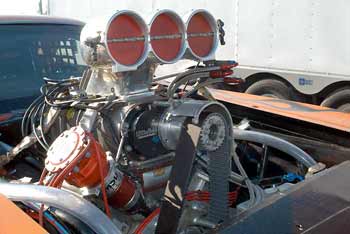Like so many racers, Savannah, GA’s Jim Arpin developed an interest in hot cars while still in high school. After moving south at 15 years old from his hometown of Providence, RI, Arpin soon became the proud owner of a ’73 Barracuda and a lifelong affiliation with Mother Mopar began.
Over the years, Arpin estimates owning 40-plus Mopar products, including Daytonas, Superbirds and Vipers, but the one that’s remained in his possession the longest is this ’70 Cuda, purchased in 1982 as a roller for the princely sum of $150, though included in the deal were a pair of 440 engines, two 383s, “and as a bonus it had a $75 Black & Decker grinder in the trunk.”
 After six years of neglect since being taken off the road in 1976, and
despite the skepticism of his father, Arpin dropped in one of the 440s
and returned the prematurely aged Cuda to drivable condition. He gradually
set about boosting its street cred, installing the usual speed parts
over the next decade or so before swapping in an Indy Cylinder Heads-built
500 cubic incher on nitrous.
After six years of neglect since being taken off the road in 1976, and
despite the skepticism of his father, Arpin dropped in one of the 440s
and returned the prematurely aged Cuda to drivable condition. He gradually
set about boosting its street cred, installing the usual speed parts
over the next decade or so before swapping in an Indy Cylinder Heads-built
500 cubic incher on nitrous.
By the late-‘90s, Arpin felt ready to take it to the next level and had local chassis man Kenny Nelson give it the Pro Street treatment, back-halving the car from the rear seats and installing ladder bars and tubs to enclose the big back meats. Another engine upgrade to a B1 588 cubed monster with three stages of nitrous soon followed, but by 2001, “it started getting a little bit faster, a little bit faster, and before long it really wasn’t streetable anymore,” Arpin realized. So it went back to Nelson for a full tube-chassis treatment from the firewall on back and it became a dedicated racecar.
 Late in 2002, Arpin qualified the reborn Cuda 15th
in a 32-car field at the Orlando World Street Nationals after running
8.31 seconds over the quarter mile on true 10.5 rear slicks. Since
then, he’s made
one more engine change, going this past March to the 526 c.i.,
alcohol-burning, blown Hemi that currently rides up front.
Late in 2002, Arpin qualified the reborn Cuda 15th
in a 32-car field at the Orlando World Street Nationals after running
8.31 seconds over the quarter mile on true 10.5 rear slicks. Since
then, he’s made
one more engine change, going this past March to the 526 c.i.,
alcohol-burning, blown Hemi that currently rides up front.
The engine is based on a Keith Black block and features Veney heads dominated by a Littlefield 16:71 hi-helix blower on top, Arpin did the engine assembly himself, installing GE pistons and JRP aluminum rods rotating on a Crower crank, while Precision Tune II in nearby Sylvania, GA, performed all the machine work. Timing is controlled by a Comp Cams camshaft, with MSD providing the spark and a set of Camtech 2.5-inch headers escorting spent gasses to a pair of Duramax 5-inch mufflers.